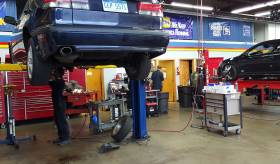How Coverage Limits Work for Car Insurance

A common fear of people that are looking to purchase automobile insurance policies is that they will either have too little car insurance coverage, or they will have too much auto insurance coverage. There is a balance to finding out how much car insurance is needed for drivers. There are a wide variety of variables that help determine the car insurance rates you are paying, and one of the things that affects the price is the coverage limits that you suggest.
One of the first things to determine when purchasing car insurance is which types of policies you need to get to meet state minimum requirements for car insurance. Another essential part of buying the best car insurance policy to meet your needs is determining whether or not it makes sense to add additional car insurance coverage above the minimum limits and whether or not to purchase comprehensive car insurance coverage or collision car insurance coverage. These are often not included as a required insurance but can help people save a lot of money if they are involved in an accident.
How Coverage Limits Work
The most important thing that you need to know about car insurance is that it is state-mandated. Each state has a minimum liability coverage limit that people need to purchase to drive legally in the state. In most cases, the minimum liability limits for car insurance are too low to protect the person driving adequately. Because of this, car insurance providers offer a wide range of coverage amounts.
Each state in the country has its own laws regarding car insurance, including how much car insurance a person needs to have to drive legally. Some states only require liability car insurance, while others require uninsured motorist coverage, UIM coverage, personal injury protection, or other types of insurance. There are several different auto insurance coverage types to consider, and some of these are not required.
When choosing the amount of coverage you get, keep in mind that the more coverage you choose to carry, the higher your premiums will be. One of the ways to get the best deals on car insurance is to look for discounts to help keep your auto insurance premiums down. While unrelated to coverage limits directly, it is good advice in any situation.
What Types Of Car Insurance Coverage Are Available?
There are quite a few car insurance coverage types, including bodily injury liability, property damage liability, collision insurance coverage, comprehensive insurance coverage, uninsured motorist coverage, underinsured motorist coverage, and personal injury protection coverage. These are the basic types of car insurance, and while they are not all required in every state, they each cover different things and can have a lot of value.
Liability insurance coverage, both bodily injury and property damage, cover someone else’s expenses involving injury or property damage if an accident occurs, and it is deemed to be your fault. Without this insurance type, the other driver could sue you for damages, which can be quite expensive.
Underinsured/Uninsured Motorist Coverage helps cover expenses if you are not at fault in an accident, but the other driver does not have enough insurance to cover your damages. This is protection that helps you pay for your own expenses if an accident occurs.
Collision insurance coverage is for accidents that involve other vehicles or structures. Regardless of who is at fault, collision coverage will cover damage to your own vehicle.
Comprehensive coverage will pay expenses related to the repair of your vehicle if it is damaged by a covered peril, which can include things like hail, fire, and vandalism.
Personal Injury Protection (PIP) is required by some states and pays for the medical costs of the person holding the policy. This is particularly important if the policyholder does not have a health insurance plan of their own.
There are other types of automobile insurance coverage to consider as well, including roadside assistance, lease gap insurance, custom parts and equipment coverage, and even pet injury insurance. Take a look at all of the insurance types that are offered, and decide which ones are best for you to have.
Factors To Consider When Purchasing Your Auto Insurance Limits
The basic insurance types listed and described above often have coverage limits. If your limits are set too low, then they might not cover all of the expenses that you incur if an accident were to happen. If you have too much insurance in terms of coverage limits, you’ll end up paying a lot more for your premiums than you need to. Finding a balance is important to do.
A first step is researching the area that you live in to determine the cost of automobile accidents in your state, as well as the likelihood of things like theft and damage from weather. Using this information will help you decide if you should get a higher automobile insurance limit on your policy, and which types of insurance should have higher limits. It is smart to carry enough coverage to cover expenses that could occur from a severe accident in your area. This will help you to not be caught having to pay out-of-pocket for what could end up being a large sum of money.
For comprehensive coverage and collision coverage, you will want to get enough coverage to pay for the current value of your vehicle.
Lastly, you will want to consider where you live and whether or not you are in a tort state. If you can be sued for losses that happen because of an accident, you will want to make sure you have a sufficient amount of coverage in case the situation happens. Again, you will want to refer to your state statistics and make sure that you have enough liability coverage to cover a serious accident.




Add new comment